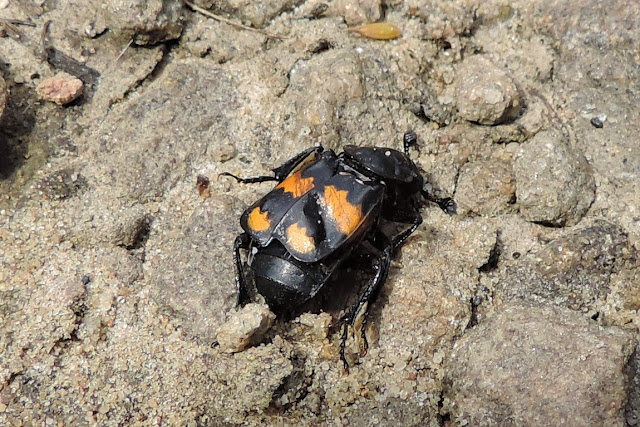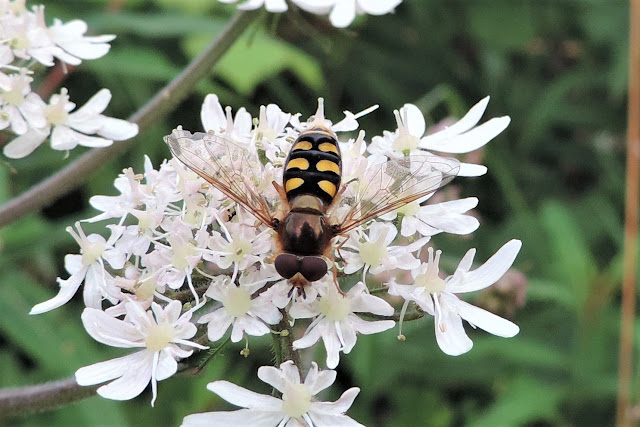Hot day at 25c with very little wind, hoverflies were hard to come by away from the Hogweed and Angelica. I've been spoilt the last couple of days, but today only managed 33 species with very little of interest besides 2 Eristais rupium.
So my mind wandered to other species and I had a good cross-section of families (see photos below)
Antler Moth - unusualy feeding by day on creeping Thistle
lots of young Common Frogs around the rain puddles
Common Shrew - 2 dead together is a first, could be motorcycle casualties [run over that is and not crash victims 😁]
Nicrophorus vespilloides - a burying beetle next to the shrew, it to looks like it has been run over by something
I think this is a Ruby Tiger caterpillar - [Sid can you confirm]
longhorn beetle Stictoleptura rubra - 3 seen today
OK, one hoverfly photo - Leucozona laternaria, 17 seen today compared to 14 Leucozona glaucia
Fairy Flax - a common UK plant of dry grasslands. How I've never seen it before I don't know, there were literally thousand's in bloom today. It is very small and I was on my knees when I spotted it though.
Tuesday, 25 July 2017
Monday, 24 July 2017
Parc Tir-iarll, Cwmfellin
Sid was parked up as I arrived, but didn't bump into him on my circuit. Another good day for hoverflies with 40 species recorded on the Hogweed and some interesting specimens taken including Cheilosia and Pipizella, both maybe new for valley. Temperatures was 20c when I arrived but increased to 23c through the afternoon and this meant that hoverflies decided to have a rest with many resting on shady leaves and out of the direct sunlight. Highlights included Dasysyrphus pinastri and another 14 Scaeva pyrastri, this migrant is having a very good year.
Also recorded the longhorn beetle Leptura quadrifasciata, there's been less than half a dozen records for the valley so was a good find here. Otherwise all the usual suspects although butterflies were out in good numbers particularly the Gatekeeper.
Leptura quadrifasciata
Cheilosia impressa
Leucozona glaucia
Melangyna compositarum agg.
Melanostoma scalare - dead and infected with the Entomphthora fungus, which affects the brain of the insects making them climb to the top of a tall plant, where they hang upside down and die so the white spores can disperse more easily in the wind.
Also recorded the longhorn beetle Leptura quadrifasciata, there's been less than half a dozen records for the valley so was a good find here. Otherwise all the usual suspects although butterflies were out in good numbers particularly the Gatekeeper.
Leptura quadrifasciata
Cheilosia impressa
Leucozona glaucia
Melangyna compositarum agg.
Melanostoma scalare - dead and infected with the Entomphthora fungus, which affects the brain of the insects making them climb to the top of a tall plant, where they hang upside down and die so the white spores can disperse more easily in the wind.
Saturday, 22 July 2017
Lletty Brongu Lanes
After three days rain and people mentioning that there are very few hovers about after the rain, I waited till the afternoon and better weather to take a walk. It was quite warm at 20c and very little wind but was overcast on times. When not expecting much you always end up with a good day, I realized this when I got out of the car and the first hogweed plant has 7 species of hoverfly on it. In a 1 mile round walk hoverflies were everywhere and in huge numbers. I recorded over a 1000 flies of 45 species on the Hogweed and supporting plants, which was a new daily record for me beating last years 43 at Blaencaerau around the same time of year. With so many hoverflies I didn't notice much else except for a couple of longhorn beetles Rutpela maculata and some tortrix moths in Pammene aurana.
Chrysotoxum species - a large individual showing characteristics of both "cautum" and "elegans" [the 2 larger ones of the genus]. For cautum it shows on the antennae seg 1 is shorter than seg 2, but also shows seg 1 + seg 2 is longer than seg 3 which should not be in cautum but in elegans. Also the thoracic hairs are pale and not as long as the antennae are wide again favouring elegans. The second picture shows that the yellow on tergite 2 bends down and thickens to the lateral margin like on elegans, on cautum it should be straight to the margin. I kept the specimen and it keys out to elegans. I'll send the photos to Roger Morris of HRS to see if he can add anything on the ID. Otherwise we will have to wait until the end of the year when the specimens are assessed. I'll update with his thoughts when I get a reply. update - From photos Roger Morris reckons it's Chrysotoxum cautum [worth a try though 👮]
Chrysotoxum bicinctum
Dasysyrphus albostriatus
Epistrophe grossulariae
Eupeodes latifasciatus - key'ed out
Leucozona glaucia
Myathropa florea
Platycheirus granditarsus
Scaeva pyrastri
Chrysotoxum species - a large individual showing characteristics of both "cautum" and "elegans" [the 2 larger ones of the genus]. For cautum it shows on the antennae seg 1 is shorter than seg 2, but also shows seg 1 + seg 2 is longer than seg 3 which should not be in cautum but in elegans. Also the thoracic hairs are pale and not as long as the antennae are wide again favouring elegans. The second picture shows that the yellow on tergite 2 bends down and thickens to the lateral margin like on elegans, on cautum it should be straight to the margin. I kept the specimen and it keys out to elegans. I'll send the photos to Roger Morris of HRS to see if he can add anything on the ID. Otherwise we will have to wait until the end of the year when the specimens are assessed. I'll update with his thoughts when I get a reply. update - From photos Roger Morris reckons it's Chrysotoxum cautum [worth a try though 👮]
Chrysotoxum bicinctum
Dasysyrphus albostriatus
Epistrophe grossulariae
Eupeodes latifasciatus - key'ed out
Leucozona glaucia
Myathropa florea
Platycheirus granditarsus
Scaeva pyrastri
Tuesday, 18 July 2017
Llangynwyd lanes
Lots of Hogweed around the lanes of Llangynwyd today. But with temperatures hitting a sultry 26c I wasn't expecting much. I did however record 27 species of hoverfly. The highlight being a Pipiza species - see below.
I took a quick photo of this Pipiza before potting it as they can't be done with photos for sure and are regarded by experts as the most difficult family in the hoverfly super family. When I checked against the keys I can't make it anything but "lugubris", this is the rarest of the Pipiza and there are only 2 records for Wales, both from the Gower coast. I've tried and re-tried to ID it but it still comes out lugubris. So we wont know the true identity until I send off my samples at the end of the season to Roger Morris at the Hoverfly recording scheme. Finger's crossed 🔍🔎🔍🔎.
Other insects see today -
Tachinid Fly - Phasia hemiptera
Epistrophe grossulariae
Dasysyrphus albostriatus
I took a quick photo of this Pipiza before potting it as they can't be done with photos for sure and are regarded by experts as the most difficult family in the hoverfly super family. When I checked against the keys I can't make it anything but "lugubris", this is the rarest of the Pipiza and there are only 2 records for Wales, both from the Gower coast. I've tried and re-tried to ID it but it still comes out lugubris. So we wont know the true identity until I send off my samples at the end of the season to Roger Morris at the Hoverfly recording scheme. Finger's crossed 🔍🔎🔍🔎.
Other insects see today -
Tachinid Fly - Phasia hemiptera
Epistrophe grossulariae
Dasysyrphus albostriatus
Blaencaerau part 2 - images
Chrysotoxum bicinctum
Eupeodes corollae
Eupeodes male - probably luniger as females were close by
Helophilus trivittatus
Melangyna compositarum agg.
Scaeva pyrastri
Sphaerophoria scripta
Xanthogramma pedissequum s.s.
Gatekeeper - good numbers today 20+
Keeled Skimmer - male
Eupeodes corollae
Eupeodes male - probably luniger as females were close by
Helophilus trivittatus
Melangyna compositarum agg.
Scaeva pyrastri
Sphaerophoria scripta
Xanthogramma pedissequum s.s.
Gatekeeper - good numbers today 20+
Keeled Skimmer - male
Monday, 17 July 2017
Eriozona syrphiodes at Blaencaerau
36 species of hoverfly recorded today and will update later, but this species deserves it's own post. Eriozona syrphoides is a scarce hoverfly it was only discovered in Great Britain in the 1960's in North Wales. Since then it has slowly spread across the country and into Glamorgan. It was recorded once last year in the valley at Garnwen by Paul Tabor, so this is the second record for the valley and the fourth for Glamorgan. The valley records are the furthest south it has been recorded in Wales.
Friday, 14 July 2017
Llangynwyd Lanes
Walked along the lanes of point to point, there was plenty of hogweed and the first of the Angelica blooming. But a stiff wind kept insect numbers down, temperature was 19c. 24 species of hoverfly seen but nothing special. Other insect highlights included the valleys second Bilberry Bumblebee, also the valleys second Golden Horsefly. Plenty of Palmate Newts in the pools and I potted a small soldier beetle, the ones with the small elytra with yellow tips that can't be done from photos. Under magnification when I got home it was quite straight forward to identify with the ID key and turned out to be Malthodes marginatus which is new for the valley. There were a lot of butterflies on the wing today with highlights being Comma and both common Skippers. I looked for Essex Skipper as this was the site I had them last year but no luck this time.
Large Skipper
Small Skipper
Eupeodes luniger
Large Skipper
Small Skipper
Eupeodes luniger
Thursday, 13 July 2017
Garnwen tracks
Bit cloudier today but still 21c although it didn't feel like at times. Only 20 species of hoverfly recorded as the late summer blooms of Hemp Agrimony, Angelica and Feverfew have not yet bloomed, so the main flowering plants are what's left of the Bramble and a few Hogweed plants. These 2 weeks are pretty quiet up Garnwen, nevertheless I thought I'd give it a go. Highlights for hoverflies being 3 Baccha elongata, Scaeva pyrastri and Sericomyia silentis.
Other insects included the Green Leafhopper (Cicadella viridis) and the first of the year for the scarce longhorn beetle Stictoleptura rubra (female with red thorax). Otherwise Red Hemp Nettle was my 300th flower/tree/shrub since I started recording first blooms of the year in 2016.
Cicadella viridis - adult above, nymph below
Common Shrew - I think, soon to be feast for Carrion Beetles
Stictoleptura rubra - female
Scaeva pyrastri - continental migrant
Sericomyia silentis
Other insects included the Green Leafhopper (Cicadella viridis) and the first of the year for the scarce longhorn beetle Stictoleptura rubra (female with red thorax). Otherwise Red Hemp Nettle was my 300th flower/tree/shrub since I started recording first blooms of the year in 2016.
Cicadella viridis - adult above, nymph below
Common Shrew - I think, soon to be feast for Carrion Beetles
Stictoleptura rubra - female
Scaeva pyrastri - continental migrant
Sericomyia silentis
Subscribe to:
Comments (Atom)

















































